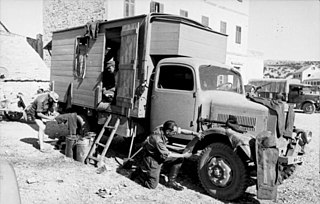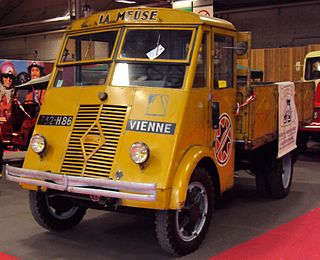 W
WThe Borgward B 3000 was a medium-sized truck made by German manufacturer Carl F. W. Borgward GmbH between 1941 and 1944 in the Bremen-Sebaldsbrück works. After World War II, B 3000 production continued from July 1948 to 1950. Also an electric driven version Borgward BE3000 was avail.
 W
WThe Borgward IV, officially designated Schwerer Ladungsträger Borgward B IV, was a German remote-controlled demolition vehicle used in World War II.
 W
WThe L 2 H 43 and L 2 H 143 "Krupp-Protze" was a six-wheeled 6x4 German truck and artillery tractor produced between 1934 and 1941 and heavily used in World War II. It was powered by a 4-cylinder, 55 hp or, from 1936, 60 hp Krupp M 304 petrol engine. Its main purpose was to tow artillery, especially the PaK 36, and transport motorized infantry.
 W
WThe M42 Truppenfahrrad was a military bicycle issued to the Heer and Waffen SS during World War II. Special equipment for military use was: the steering bar, the saddle, the toolbox and the porter at the back. On the steering bar were holders mounted for holding a variety of items, such as a half-shelter tent, clothing, and panzerfausts. The mid-section could be fitted to hold machineguns. The headlamp was made to work with dynamo and/or battery.
 W
WThe Mercedes-Benz L3000 was a 4x2 3-ton rear axle drive truck used by Germany in World War II, powered by a Daimler-Benz OM 65/4 74 hp 4-cylinder diesel engine. It was used alongside the Opel Blitz, and proved even more reliable in rough terrain; and was used in all fronts and extensively by the Afrika Korps. It was manufactured in three versions, the L3000, the L3000A, and the L3000S, from 1938 to 1943; by that time more than 27,700 of all versions had been built. This made it the most produced Mercedes-Benz truck of World War II.
 W
WOpel Blitz was the name given to various light and middle-weight truck series built by the German Opel automobile manufacturer between 1930 and 1975. The original logo for this truck, two stripes arranged loosely like a lightning symbol in the form of a horizontally stretched letter "Z", still appears in the current Opel logo.
 W
WRadschlepper Ost, literally "Wheeled Tractor East", also known as Škoda RSO or Porsche 175, was a German heavy 4WD military tractor used during World War II. It was designed by Ferdinand Porsche in 1941 and produced by Škoda in Mladá Boleslav. Around 206 vehicles were produced between the years 1942–1944.
 W
WRaupenschlepper Ost was a fully tracked, lightweight vehicle used by the Wehrmacht in World War II. It was conceived in response to the poor performance of wheeled and half-tracked vehicles in the mud and snow during the Wehrmacht's first autumn and winter on the Soviet Front.
 W
WThe Renault AHx was a range of light/medium trucks with carrying capacities from 2 to 5 tonnes manufactured by Renault between 1941 and 1947. Various versions were used in World War II by the German forces.
 W
WThe Mittlerer Ladungsträger Springer, Sd.Kfz. 304) was a demolition vehicle of the German Wehrmacht in World War II.
 W
WThe Volkswagen Typ 87, also known as the Kommandeurswagen, was a World War II, four-wheel-drive version of the Volkswagen Beetle. It was produced from 1941 to 1944 by the Volkswagen plant, primarily for the Wehrmacht. The Wehrmacht classified the Kommandeurswagen as leichter geländegängiger PKW, 4-sitziger, 4-radgetriebener Geländewagen Typ 87.. The drivetrain and the engine are the same as in the Volkswagen Typ 166 Schwimmwagen amphibious vehicle. 564 units of the Kommandeurswagen were produced; in November 1946, the Volkswagen plant produced two more vehicles using parts from stores.
 W
WThe Volkswagen Kübelwagen, was a light military vehicle designed by Ferdinand Porsche and built by Volkswagen during World War II for use by the German military. Based heavily on the Volkswagen Beetle, it was prototyped as the Type 62, but eventually became known internally as the Type 82.
 W
WThe VW Type 128 and 166 Schwimmwagen were amphibious four-wheel drive off-roaders, used extensively by German ground forces during the Second World War. The Type 166 is the most numerous mass-produced amphibious car in history.